Alienware M18x R2 Notebook Review: NVIDIA's GeForce GTX 680M in SLI
by Dustin Sklavos on September 28, 2012 12:01 AM ESTDisplay and Build Quality
Given that the Alienware M18x R2 uses an identical display panel and shell to the original M18x, it doesn't make too much sense to revisit those stats in any great detail; all of my conclusions regarding the M18x's shell are again applicable here. I'm not a fan of notebooks this oversized, and the macro keys on the side actually make the keyboard more difficult to touch type on. As for the display itself, a visit to bench reveals that not much has changed. The M18x R2 is using a slightly brighter backlight which hits the contrast just a little bit, but basically there's no news to report here.
Battery Life
When comparing the M18x R2 to its predecessor it's important to note that there are a couple of things bound to affect the battery life results. It's not just that Ivy Bridge is a more efficient chip than Sandy Bridge was, but the i7-3820QM in the R2 is also rated at 10W lower than the preceding i7-2920XM. On top of that, we've switched over to two SSDs in a RAID 0 instead of two mechanical disks, which again should prove to be more power efficient.
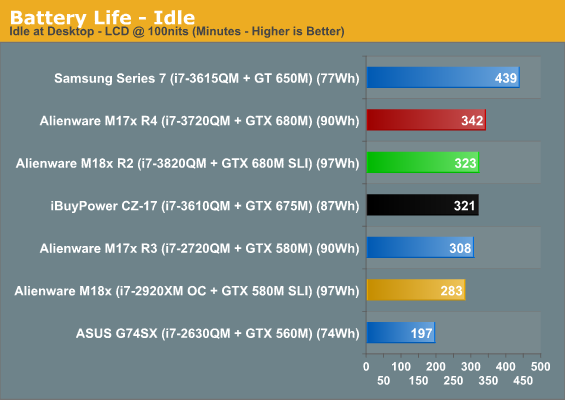
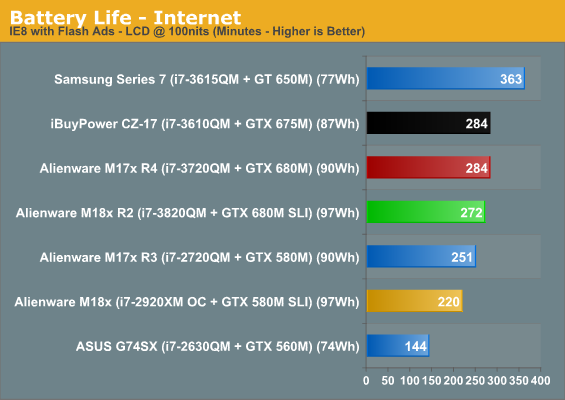
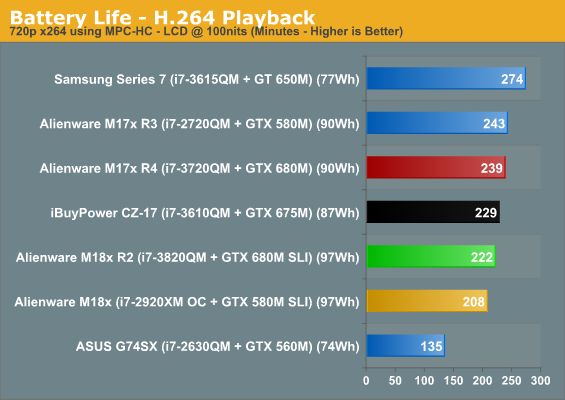
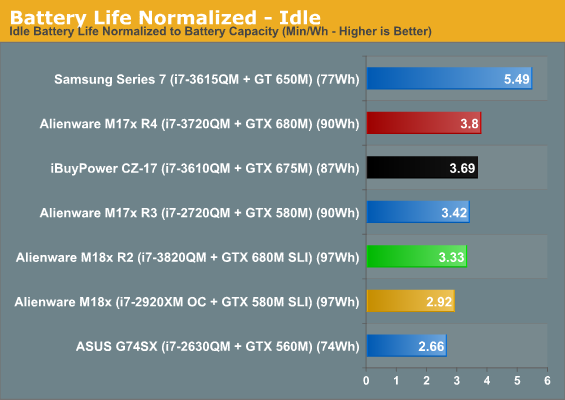
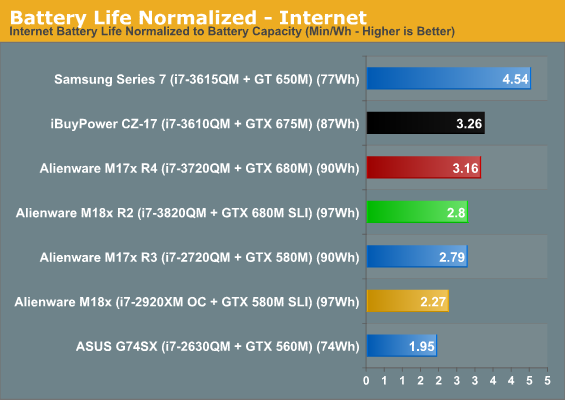
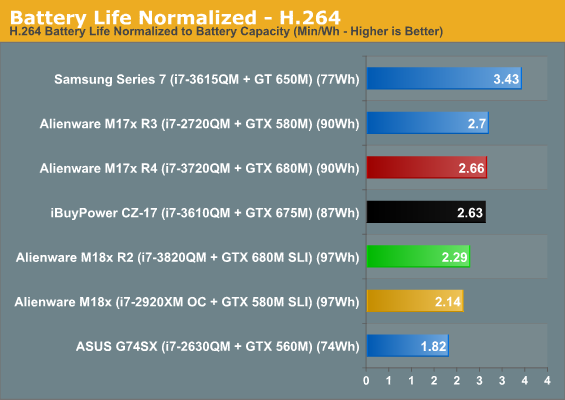
Interestingly the newer M18x R2 enjoys roughly the same level of gains in efficiency as the M17x R4 did over its predecessor despite having theoretically greater advantages. That's not a bad thing, necessarily; it may just be that the 18.4" display is sucking up the lion's share of the power on its own. Since the notebooks were switched to integrated graphics for our battery testing, the two 680Ms in SLI don't really affect the power consumption at all.
Ultimately the M18x R2 can pull roughly four hours of useful running time on the battery, which is none too shabby for an enormous gaming notebook.
Heat and Noise
Where the Alienware M18x R2's girth really excels is in being able to transfer what's essentially a cumulative 245W of heat out of the chassis. It's actually remarkably efficient that way, too. Under sustained load the M18x R2 is definitely audible, registering roughly 40dB of noise to the user. Extreme duress punches it up to around 47dB, but that's not going to be as common. When you consider what the notebook is actually cooling these results are pretty reasonable.

You can see thermals are actually pretty good. The system seems to be configured more for silence than thermal performance, with the i7-3820QM breaking the 90C mark, but the two 680Ms run comparatively frosty. They actually run cooler than my desktop 680 does despite being together in a more enclosed space.










50 Comments
View All Comments
PCMerlin - Saturday, September 29, 2012 - link
Wow.... Either you guys missed the "or better" aspect of it or you just haven't been paying attention to what the rest of the world is doing.Apple is offering up to 2880x1800 on MacBook Pro Retina (problem is, I'm not too keen on Apple). Retina screen resolutions are also available on i-Pads and i-Phones.
Android phones and tablets are also catching up to those resolutions, Asus has a 1920x1200 on their 10.1" Transformer now.
New TV's are coming out with 4k UHD (2160p)
My 4 year old Gateway has a 1920x1200 screen - all I'm asking is why the PC market feels that 1080p is "good enough" when the rest of the world is aiming higher?
If high-resolution PC laptops are dead, then my prediction is that the PC laptop itself will soon be dead, also.
seapeople - Sunday, September 30, 2012 - link
Would be interesting if they put 2560x1440 in this thing, considering the graphics power.JPForums - Monday, October 1, 2012 - link
No. It is my money and I can buy what I want. If I want 1920x1200 and they aren't offering, there is nothing forcing me to buy their product. Also, if I never make them aware that they lost a sale due to the panel, then it will never get addressed.On the flip side. While 1920x1200 is not in fact dead, it has been largely relegated to high end offerings (with high end price tags). Now I must make a choice to spend the extra cash or do without. For the laptop market, I must also decide whether I can live with the other tradeoffs. For instance, I may be able to get 1920x1200 in a mobile workstation, but I also have to buy a workstation graphics card that isn't optimized for gaming. This may or may not be acceptable to me if I value gaming. High end workstation graphics, last I checked, had worse optimus support than their consumer counter parts. If I value optimus, this may not be acceptable.
My personal number one issue is that most laptops don't have what I consider to be adequate cooling. I don't like to see my graphics cards breach 90C, much less my processor. Thermal throttling due to inadequate cooling (even with help) was the achilles heal of the M6400 I used at work (before it fried) and I'm not satisfied with <10C of margin before the dust even starts building up. Unfortunately, good cooling solutions seem to be mutually exclusive to 1920x1200 screens on performance laptops, so I'm now at 1920x1080 due to my prioritization.
If PCMerlin prioritizes screen resolution, that is his choice to make. Alternately, he could buy the laptop and purchase an additional 1920x1200 or better monitor for when he's docked like I did.
Old_Fogie_Late_Bloomer - Saturday, September 29, 2012 - link
You know what would make this whole 16:9/16:10 discussion go away? If they kept the same aspect ratio and physical size and just upped the resolution/pixel density. A 2160x1215 screen would have more vertical pixels than our old favorite and a nigh-perfect 134.7 ppi at 18.4".Do I prefer 16:10 over 16:9? Sure. Do I prefer 1440x900 over 1600x900? Nooope. Would a 2160x1215 screen be more expensive to manufacture than a 1920x1080 screen at the same size? Not significantly, since the size of the screen drives the price more than it's resolution.
What kills this Alienware (well, all Alienware laptops) for me, though, is the glossy screen. There's no way I'd pay more than a few hundred dollars for a laptop that has one.
seapeople - Sunday, September 30, 2012 - link
Don't know where you've been, but most of these 16:9 whinefests contain at least a few comments of people specifically mentioning how they would prefer 1440x900 over 1600x900 because of how the aspect ratio is just inherently superior...Sufo - Monday, October 1, 2012 - link
Rubbish. The complaint is 1080 vs 1200. WUXGA can display 2 documents side by side comfortably. This is what is was designed for. Anything lower will not. Anyone who is found arguing that 1440x900 is superior to 1600x900 should not be counted towards the collected opinions of 16:10 supporters. The sad fact of the matter is that 1440x900 was replaced, by and large, by 1333x768 which is, by all accounts, a travesty.noblemo - Friday, September 28, 2012 - link
Thank you, Dustin, for both the M17x R4 and M18x R2 reviews. As a general question, are the display benchmark tests performed on the unit as shipped, or do you run a calibration first?Dustin Sklavos - Friday, September 28, 2012 - link
We run a calibration first.noblemo - Friday, September 28, 2012 - link
Thank you for replying.Tchamber - Friday, September 28, 2012 - link
"It's heavy enough that it can be uncomfortable on your lap or even to cart around from place to place..."I still have my old HP HDX9000 20" laptop that weighs neigh on 15lbs lol, its collecting dust except when I want to use its HD dvd player. My M17xR1weighs as much as this 18xR2, so I feel like its a bargain as far as size/weight is concerned. Its impressive how far laptops have come in the last few years.